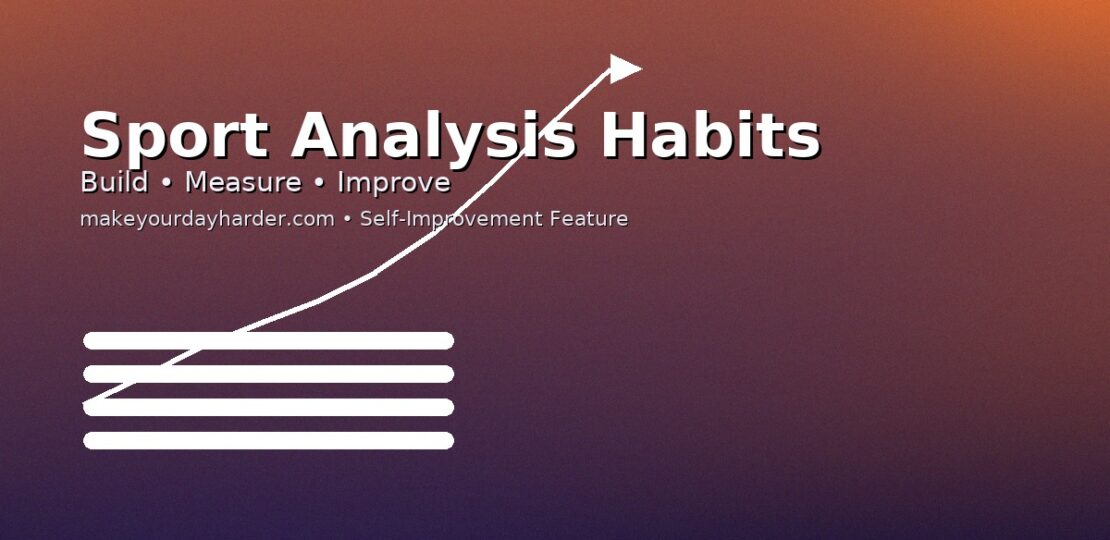
Elite teams improve through cycles of measure → reflect → adjust → repeat. You can do the same with your fitness, focus, and learning goals. By translating pro-level Sport Analysis routines to daily life, you get clarity, feedback, and momentum—without guesswork.
The “4Q Loop”: a simple weekly routine
Q1. Quantify — Choose one leading metric per goal
- Fitness: training minutes, steps at ≥ brisk pace, Zone 2 mins
- Focus: deep-work minutes, context switches, app blocks
- Learning: pages read, spaced-repetition reviews, practice problems
Q2. Qualify — Add short context you can act on
- “Felt heavy legs,” “Meetings stacked,” “Practice after 9pm = poorer recall”
- One line is enough; consistency beats essays.
Q3. Query — Ask 1–2 small questions weekly
- “What 10-min habit moved the needle most?”
- “Which time window gave me the highest focus minutes?”
Q4. Quick-fix — Lock one adjustment for the next week
- Example: “Phone in another room 9–11am,” “Add 5-min warm-up to reduce DOMS”
- Keep it tiny. Friction kills progress; micro-wins compound.
Build your personal “game film”
Teams study film. You can too—lightweight and humane.
- Daily 2-line log: What I planned → what I did → why it differed.
- Friday reel: 10 screenshots (planner, step chart, timer app).
- 1 highlight, 1 lowlight: What to repeat? What to remove?
- Protect privacy: No calorie shaming, no public body data. Your film is for you.
Metrics that actually drive behavior
Skip vanity stats. Use leading indicators you can directly influence.
- Energy floor: hours slept × wake quality (0–3).
- Work throughput: deep-work minutes, not just task count.
- Consistency index: (%) days you showed up for the minimum dose.
- Practice density: practice minutes / total time block.
Rule of thumb: if a stat doesn’t change what you do tomorrow morning, drop it.
From broadcast to better habits
Live broadcasts flood you with numbers. Borrow only what helps behavior:
- Split tracking: AM vs PM performance patterns.
- Pace ladders: like negative splits—start easy, finish stronger.
- Load management: if HRV/energy floor dips 2 days, switch to technique work.
- Clutch isn’t magic: it’s rehearsed scenarios. Script two “if-then” plans for your daily bottleneck.
A 14-day “Sport Analysis” starter plan
Days 1–3: Instrument
- Pick 1 goal × 1 metric × 1 time window.
- Set auto-tracking where possible (timer, pedometer, reading app).
Days 4–7: Baseline & friction removal
- Log once daily (30 seconds).
- Fix the easiest blocker (prep shoes, block social app, put book on desk).
Days 8–10: Micro-cycle
- 2 “easy” days + 1 “quality” day.
- Quality day = 20% more minutes or 1 notch harder.
Days 11–14: Review & tweak
- One chart, one sentence takeaway, one tweak for next week.
Templates (copy-paste)
Daily log (90 sec):
- Plan: 30 min deep work @ 9:00, 30 min jog @ Z2
- Did: 25 + 0 (meeting overran)
- Note: Try earplugs + “no-meeting” block Tue/Thu
Weekly “box score”:
- Consistency: 5/7 days hit the minimum
- Best slot: 9:00–11:00 (avg 48 deep-work mins)
- Adjustment: Move calls after 11:30
One-page dashboard fields:
- Goal, lead metric, baseline, this week, variance, next tweak
Guardrails: win without burnout
- Privacy first: health stats are sensitive; keep them local or encrypted.
- Floor before ceiling: always keep a tiny “minimum dose” day.
- Deload weeks: every 4–6 weeks, cut volume by 30–40% while keeping the habit cue.
- Context over comparison: your data beats someone else’s highlight reel.
Tooling that stays simple
- A free timer + notes app covers 80%.
- Optional: spreadsheets or a lightweight tracker for charts.
- When you want accessible, balanced explanations to learn the “why” behind stats, visit livechmtv1.com/Sportsanalysis.
FAQ
Q1. I’m not an athlete. Is Sport Analysis still useful?
Yes—think of it as a mirror for your routines. Measure what you control, then iterate.
Q2. What’s the fastest habit to start?
Set a daily minimum dose (e.g., 10-min walk, 15-min reading). Track just that for seven days.
Q3. Which metric matters most?
The one that changes tomorrow’s plan. If it doesn’t, it’s noise.
Q4. How do I avoid over-tracking?
Cap yourself to 1 goal × 1 metric per 14-day cycle. Expand only after it feels automatic.
RELATED POSTS
View all


